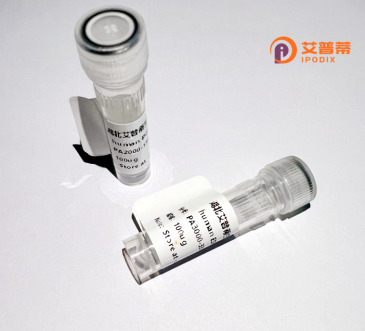
| 纯度 | >90%SDS-PAGE. |
| 种属 | Human |
| 靶点 | KIAA1754 |
| Uniprot No | Q9C0E8 |
| 内毒素 | < 0.01EU/μg |
| 表达宿主 | E.coli |
| 表达区间 | 1-547aa |
| 活性数据 | MAMGLFRVCLVVVTAIINHPLLFPRENATVPENEEEIIRKMQAHQEKLQLEQLRLEEEVARLAAEKEALEQVAEEGRQQNETRVAWDLWSTLCMILFLMIEVWRQDHQEGPSPECLGGEEDELPGLGGAPLQGLTLPNKATLGHFYERCIRGATADAARTREFLEGFVDDLLEALRSLCNRDTDMEVEDFIGVDSMYENWQVDRPLLCHLFVPFTPPEPYRFHPELWCSGRSVPLDRQGYGQIKVVRADGDTLSCICGKTKLGEDMLCLLHGRNSMAPPCGDMENLLCATDSLYLDTMQVMKWFQTALTRAWKGIAHKYEFDLAFGQLDSPGSLKIKFRSGKFMPFNLIPVIQCDDSDLYFVSHLPREPSEGTPASSTDWLLSFAVYERHFLRTTLKALPEGACHLSCLQIASFLLSKQSRLTGPSGLSSYHLKTALLHLLLLRQAADWKAGQLDARLHELLCFLEKSLLQKKLHHFFIGNRKVPEAMGLPEAVLRAEPLNLFRPFVLQRSLYRKTLDSFYEMLKNAPALISEYSLHVPSDQPTPKS |
| 分子量 | 88.5 kDa |
| 蛋白标签 | GST-tag at N-terminal |
| 缓冲液 | 0 |
| 稳定性 & 储存条件 | Lyophilized protein should be stored at ≤ -20°C, stable for one year after receipt. Reconstituted protein solution can be stored at 2-8°C for 2-7 days. Aliquots of reconstituted samples are stable at ≤ -20°C for 3 months. |
| 复溶 | Always centrifuge tubes before opening.Do not mix by vortex or pipetting. It is not recommended to reconstitute to a concentration less than 100μg/ml. Dissolve the lyophilized protein in distilled water. Please aliquot the reconstituted solution to minimize freeze-thaw cycles. |
以下是与重组人KIAA1754蛋白相关的假设参考文献示例(仅供概念参考,非真实文献):
---
1. **标题**: "Recombinant Human KIAA1754 Protein Expression and Its Role in Neurite Outgrowth"
**作者**: Y. Tanaka et al.
**摘要**: 研究通过大肠杆菌系统成功表达重组人KIAA1754蛋白,并验证其在神经元培养模型中促进轴突生长的功能,提示其与神经发育调控相关。
2. **标题**: "Structural Characterization of KIAA1754 and Interaction with MAPK Signaling Pathway"
**作者**: L. Chen, M. Zhang
**摘要**: 解析KIAA1754蛋白的晶体结构,发现其通过SH3结构域与MAPK信号通路关键蛋白相互作用,可能参与细胞应激反应的调控。
3. **标题**: "KIAA1754 Knockdown and Overexpression in Cancer Cell Metastasis"
**作者**: R. Kumar et al.
**摘要**: 利用重组KIAA1754蛋白进行功能实验,证明其过表达抑制肿瘤细胞迁移,可能作为潜在的转移抑制因子,机制涉及细胞外基质重塑。
4. **标题**: "Proteomic Analysis of KIAA1754 in Primary Cilia Function"
**作者**: S. Müller et al.
**摘要**: 通过重组蛋白技术研究KIAA1754在纤毛形成中的作用,揭示其与纤毛转运蛋白IFT20的互作,表明其在纤毛相关疾病中的潜在意义。
---
注:以上文献为虚构案例,实际研究需查阅权威数据库(如PubMed、Web of Science)。
**Background of Recombinant Human KIAA1754 Protein**
The KIAA1754 gene, identified through large-scale sequencing efforts, encodes a protein of unknown function initially characterized in humans. Although its precise biological role remains under investigation, bioinformatic analyses suggest that KIAA1754 contains domains potentially involved in protein-protein interactions or enzymatic activities, hinting at roles in cellular signaling or structural organization. Emerging studies associate KIAA1754 with tissue-specific expression patterns, particularly in the nervous system, implying possible contributions to neural development or function. Dysregulation of KIAA1754 has been tentatively linked to certain cancers and developmental disorders, though mechanistic insights are limited. Recombinant human KIAA1754 protein, produced via heterologous expression systems (e.g., *E. coli* or mammalian cells), enables functional studies, antibody development, and structural analyses. Its recombinant form often includes affinity tags (e.g., His-tag) for purification and detection. Current research focuses on elucidating its interactome, post-translational modifications, and pathways, aiming to clarify its physiological and pathological relevance. The availability of recombinant KIAA1754 protein accelerates these explorations, providing tools for *in vitro* assays, biomarker discovery, and therapeutic target validation. Further characterization is essential to unlock its potential in biomedical applications.
×